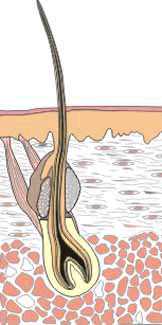|
Mice Regenerate Hair Follicles
Researchers have rebuffed conventional wisdom and shown that adult mice can regenerate hair follicles and hair after wounding. The finding suggests new directions for designing treatments for wounds, hair loss and other degenerative skin disorders.
 |
Skin layers and hair follicle.
Illustration courtesy of
National Institute for
Occupational Safety
and Health. |
Around 50 years ago, studies on rabbits, mice and humans suggested that new hair follicles could form after wounding, but definitive evidence for the idea was lacking until a new paper published in Nature on May 17, 2007. Dr. George Cotsarelis and his colleagues at the University of Pennsylvania School of Medicine had been studying wound healing in mice when they noticed structures within large healing wounds that resembled the developing hair follicles of embryos. With funding support from NIH's National Institute of Arthritis and Musculoskeletal and Skin Diseases (NIAMS), they decided to explore the phenomenon further.
The researchers removed a 1 cm square of back skin from 3-week-old mice. Within 19 days, the healing skin had small structures that resembled developing embryonic hair follicles. The structures went on to produce a hair shaft and progress through all stages of the hair follicle cycle. Older mice also produced hair follicles after wounding, but larger wounds were required to trigger them.
At the molecular level, the researchers discovered, hair follicle formation after wounding also paralleled embryonic follicle development. Genes known to be involved in embryonic follicle development were expressed beginning several days after wounding.
Further experiments showed that the new follicles originated from cells other than hair follicle stem cells. The researchers haven't yet shown where the new follicle-forming stem cells come from, but they were able to implicate a set of proteins called Wnt in the process. Wnt proteins are known to play an important role in normal hair follicle development. Blocking Wnt activity prevented the new hair follicles from forming. Inducing higher levels of Wnt activity in skin, the researchers found, led to more hair follicles.
These results suggest that mammalian skin has much greater regenerative capacity than researchers previously believed. The findings raise the possibility of treating hair loss by developing therapies that target the Wnt pathway. The methods the researchers used also support the idea that therapies for treating acute wounds might be developed by targeting specific wound-healing molecular pathways.
—by Harrison Wein, Ph.D.
|


